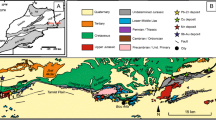Abstract
The bedded clastic ore widespread on the slopes and flanks of the deeply eroded sulfide mound at the Saf’yanovka volcanic-hosted copper massive sulfide deposit consists of products of destruction of the Paleozoic black smoker along with diverse newly formed sulfides. The size of ore clasts gradually decreases with distance from the massive ore mound, from more than tens of centimeters to a few millimeters. The clastic sediments are characterized by good preservation of sulfide material composed of hydrothermal sedimentary colloform pyrite, chalcopyrite with lamellae of relict isocubanite, and concentrically zoned sphalerite. Numerous pyrite framboids, nodules, and euhedral crystals; chalcopyrite segregations; and twinned sphalerite are typical of sulfide-bearing black shale. Enargite, tennantite, and galena were formed after pyrite, filling interstices between nodules or partially replacing and corroding the previously formed minerals. The interrelations between minerals show that the fine-clastic sulfide-bearing black shale underwent diagenesis in the presence of organic matter.
Similar content being viewed by others
References
Atlas of Textures and Structures of Base-Metal Ores of Kazakhstan (Pb, Zn, Cu) (Nauka KazSSR, Alma-Ata, 1976) [in Russian].
A. G. Betekhtin, A. D. Genkin, A. A. Filimonova, and T. N. Shadlun, Ore Textures and Structures (Moscow, 1958) [in Russian].
N. S. Bortnikov, D. T. Fedorov, and K. G. Murav’ev, “Mineral Composition and Formation Conditions of Seafloor Massive Sulfide Mounds in the Lau Basin, Southeastern Pacific,” Geol. Rudn. Mestorozhd. 35(6), 528–543 (1993).
L. N. Botvinkina, Genetic Types of Deposits in Regions of Active Volcanism (Nauka, Moscow, 1974) [in Russian].
S. N. Ivanov, “The Study of Growth Zones in Pyrite Grains from Massive Sulfide Deposits of the Urals,” Zap. Vsesoyzn. Mineral. O-va 79, 113–126 (1950).
A. V. Korovko, D. A. Dvoeglazov, N. V. Leshchev, et al., “The Saf’yanovka Zinc-Copper Deposit, Central Urals,” in Geodynamics and Metallogeny of the Urals (Ural Division, Acad. Sci. USSR, Sverdlovsk, 1991), pp. 152–153 [in Russian].
N. I. Krasnova and T. G. Petrov, Genesis of Mineral Individuals and Aggregates (St. Petersburg State Univ., Inst. Earth Crust, 1997) [in Russian].
R. R. Large, J. McPhie, J. B. Gemmell, et al., “The Spectrum of Ore Deposit Types, Volcanic Environments, Alteration Halos, and Related Exploration Vectors in Submarine Volcanic Successions: Some Examples from Australia,” Econ. Geol. 96(5), 913–938 (2001).
L. P. Listova and G. P. Bondarenko, Dissolution of Pb, Zn, and Cu Sulfides under Oxidative Conditions (Nauka, Moscow, 1969) [in Russian].
V. V. Maslennikov, Sedimentation, Halmyrolysis, and Ecology of Massive Sulfide-Bearing Paleohydrothermal Fields (Miass, 1999) [in Russian].
V. V. Maslennikov, Lithogenesis and Ore Formation (Inst. Mineralogy, Miass, 2006) [in Russian].
S. P. Maslennikova and V. V. Maslennikov, Sulfide Chimneys of the Paleozoic Black Smokers: A Case of the Urals (Yekaterinburg, 2007) [in Russian].
I. V. Pokrovskaya, Mineralogy and Formation Conditions of Base-Metal Deposits (Leninogorsk District of the Rudny Altai) (Nauka, Alma-Ata, 1982) [in Russian].
N. S. Skripchenko, Hydrothermal Sedimentary Sulfide Ores of Basaltoid Associations (Nauka, Moscow, 1972) [in Russian].
M. Solomon, F. Tornas, and O. S. Gasper, “Explanation for Many of the Unusual Features of the Massive Sulfide Deposits of Iberian Pyrite Belt,” Geology. 30(1), 87–90 (2002).
O. V. Yapaskurt, Premetamorphic Alteration of Sedimentary Rocks in Stratosphere. Processes and Factors (Geos, Moscow, 1999) [in Russian].
R. G. Yazeva, V. P. Moloshag, and V. V. Bochkarev, “Geology and Ore Mineral Assemblages of the Saf’yanovka Massive Sulfide Deposit in the Central Urals Retrocharriage,” Geol. Rudn. Mestorozhd. 33(4), 58–76 (1991).
V. V. Zaykov and V. V. Maslennikov, “On Bottom Sulfide Mounds at VHMS Deposits of the Urals,” Dokl. Akad. Nauk SSSR 293(1), 181–184 (1987).
V. V. Zaykov, V. V. Maslennikov, E. V. Zaykova, and R. Herrington, Ore-Formation and Ore-Facies Analysis of Massive Sulfide Deposits of the Ural Paleoocean (Inst. Mineralogy, Miass, 2001) [in Russian].
Author information
Authors and Affiliations
Corresponding author
Additional information
Original Russian Text © N.P. Safina, V.V. Maslennikov, 2009, published in Zapiski RMO (Proceedings of the Russian Mineralogical Society), 2009, Pt. CXXXVII, No. 4, pp. 61–75.
Rights and permissions
About this article
Cite this article
Safina, N.P., Maslennikov, V.V. Sequence of mineral formation in clastic ores of the Saf’yanovka volcanic-hosted copper massive sulfide deposit, the Central Urals. Geol. Ore Deposits 51, 633–643 (2009). https://doi.org/10.1134/S1075701509070125
Received:
Published:
Issue Date:
DOI: https://doi.org/10.1134/S1075701509070125




